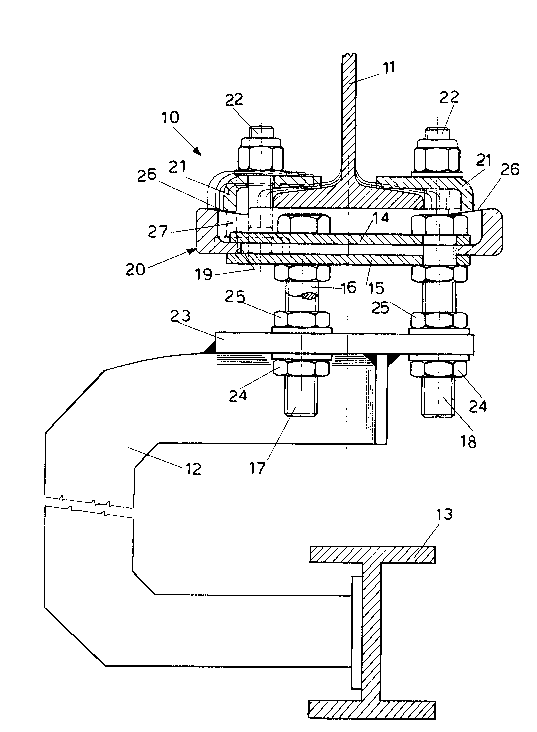Some of the information on this Web page has been provided by external sources. The Government of Canada is not responsible for the accuracy, reliability or currency of the information supplied by external sources. Users wishing to rely upon this information should consult directly with the source of the information. Content provided by external sources is not subject to official languages, privacy and accessibility requirements.
Any discrepancies in the text and image of the Claims and Abstract are due to differing posting times. Text of the Claims and Abstract are posted:
| (12) Patent Application: | (11) CA 2136495 |
|---|---|
| (54) English Title: | DISK-TYPE ADJUSTABLE SUPPORTING DEVICE FOR OVERHEAD RUNWAYS |
| (54) French Title: | SUPPORTS A DISQUES POUR TRANSPORTEUR AERIEN |
| Status: | Deemed Abandoned and Beyond the Period of Reinstatement - Pending Response to Notice of Disregarded Communication |
| (51) International Patent Classification (IPC): |
|
|---|---|
| (72) Inventors : |
|
| (73) Owners : |
|
| (71) Applicants : |
|
| (74) Agent: | SMART & BIGGAR LP |
| (74) Associate agent: | |
| (45) Issued: | |
| (22) Filed Date: | 1994-11-23 |
| (41) Open to Public Inspection: | 1996-05-24 |
| Availability of licence: | N/A |
| Dedicated to the Public: | N/A |
| (25) Language of filing: | English |
| Patent Cooperation Treaty (PCT): | No |
|---|
| (30) Application Priority Data: | None |
|---|
A supporting device (10) for overhead runways comprises a
fastening and adjusting coupling for connecting a bracket
(12) (the lower end of which is secured to the rail (13))
to an upper suspension beam (11). The coupling comprises a
first (20) and a second (23) element for connecting the
beam to the bracket, the first element defining a
circumferential rim (19), two parallel plates (14, 15)
being interconnected by bolts (16, 17, 18) which
reciprocally close together to grip said circumferential
rim between the plates thereby enabling the reciprocal
rotation of the element and plates around a vertical axis.
The plates (14, 15) have means for connecting them to the
second element which are adjustable to allow adjustment of
the reciprocal gap between the first and second element.
Note: Claims are shown in the official language in which they were submitted.
Note: Descriptions are shown in the official language in which they were submitted.

2024-08-01:As part of the Next Generation Patents (NGP) transition, the Canadian Patents Database (CPD) now contains a more detailed Event History, which replicates the Event Log of our new back-office solution.
Please note that "Inactive:" events refers to events no longer in use in our new back-office solution.
For a clearer understanding of the status of the application/patent presented on this page, the site Disclaimer , as well as the definitions for Patent , Event History , Maintenance Fee and Payment History should be consulted.
| Description | Date |
|---|---|
| Inactive: IPC from MCD | 2006-03-11 |
| Time Limit for Reversal Expired | 2002-11-25 |
| Application Not Reinstated by Deadline | 2002-11-25 |
| Deemed Abandoned - Failure to Respond to Maintenance Fee Notice | 2001-11-23 |
| Inactive: Abandon-RFE+Late fee unpaid-Correspondence sent | 2001-11-23 |
| Application Published (Open to Public Inspection) | 1996-05-24 |
| Abandonment Date | Reason | Reinstatement Date |
|---|---|---|
| 2001-11-23 |
The last payment was received on 2000-11-02
Note : If the full payment has not been received on or before the date indicated, a further fee may be required which may be one of the following
Please refer to the CIPO Patent Fees web page to see all current fee amounts.
| Fee Type | Anniversary Year | Due Date | Paid Date |
|---|---|---|---|
| MF (application, 3rd anniv.) - standard | 03 | 1997-11-24 | 1997-11-05 |
| MF (application, 4th anniv.) - standard | 04 | 1998-11-23 | 1998-10-28 |
| MF (application, 5th anniv.) - standard | 05 | 1999-11-23 | 1999-10-26 |
| MF (application, 6th anniv.) - standard | 06 | 2000-11-23 | 2000-11-02 |
Note: Records showing the ownership history in alphabetical order.
| Current Owners on Record |
|---|
| FATA AUTOMATION S.P.A. |
| Past Owners on Record |
|---|
| GIORGIO DEANDREA |